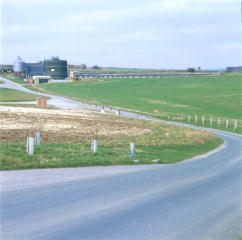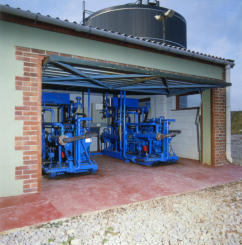Pig Waste Digestion Plant
This 850m3 digester at Hanford Farms was one of the first agricultural digesters in the UK and was the largest of its kind. The digester was designed by Dr Etheridge (now director of
Biotrix Asia Company Ltd ) in 1983 to treat the waste from 13,000 pigs (about 90m3/d at 4.5%TS). The system was operated at an 8-10 day hydraulic retention time (HRT), although shorter HRT's were commonly used.
Design of the UKs first major Pig Waste Digester
CLEAR Ltd. constructed the plant but did not install effective corrosion protection. Although the biotreatment process was a success, within three years of operation the system started to loose biogas due to corrosion of the roof (1988/9). Hanford Farms installed an internal flexible liner (geotechnical membrane) in the roof space to keep it gas tight and this was effective over the lifetime of the plant.
Biogas produced by the system was stored in a 15m3 over-water gas holder and used to fuel two SERCK 45kWe biogas engines to produce electricity and hot water, which was used to heat the digester using internal heating coils.
In the mid-1980's, the first government sponsored contract for the subsidised purchase of non-fossil fuels was launched. A scheme was established under which each electricity company had to buy a certain percentage of electricity from sources other than those consuming fossil fuels. The NFFO (Non-Fossil Fuel Obligation) programme was designed for new installations but in the first round (NFFO1), existing installations were included.
Hanford made a bid to sell electricity at a rate of 6.5p/kWh which was approved for a 10 year period. This was well above the normal peak day rate of 4.5p/kWh and far better than the existing 2.4p/kWh night rate. Hanford Farms received a substantially higher rate for the electricity it produced and exported to the grid.
Solids from the digestion process were separated using a vibrating screen to produce a peat replacement which was sold for some of the time. The remaining liquor retained its nitrogen content, was easy to pump, and had a much reduced odour. This could be stored until needed and used locally as a valuable fertiliser.
The NFFO contract lasted until about 1999 and it was at that time that Hanford reviewed the system for a refit and upgrade. The financial market for pigs at the time was not considered favourable and the company had sold its feed mill, which could use much of the electricity in future. Without the NFFO grant it became uneconomic to produce electricity to sell it at much reduced rates. It was therefore decided to shut the digester down and take it out of operation.
The following is an excerpt taken from the Financial Times Survey on "Biomass and Renewable Energy" (1999):
An Anaerobic digestion plant for pig slurry and food processing waste has operated since 1984 in Piddlehinton, Dorset. It produces just over 1 MWhld of electricity as well as waste heat from the generators which is used to heat the digester and an adjacent office building. With capital costs of around £213,000 and an annual running costs of £15,000, the plant was breaking even before the NFFO scheme. Since it was awarded an NFFO contract, electricity has been bought by the grid at a premium price and the scheme is profitable. Fibrous solids are separated from the digester waste and ploughed into the ground while the liquid residue is spread on the land as fertiliser.
Digester and Controls

Digester and Environs

CHP Equipment







